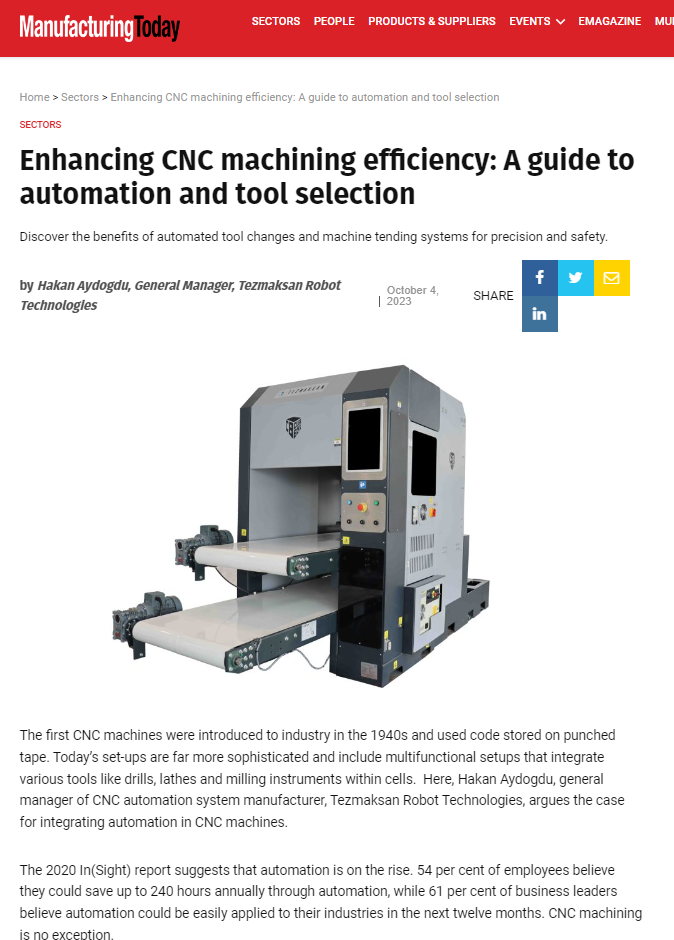
Enhancing CNC machining efficiency: A guide to automation and tool selection
The first CNC machines were introduced to industry in the 1940s and used code stored on punched tape. Today’s set-ups are far more sophisticated and include multifunctional setups that integrate various tools like drills, lathes and milling instruments within cells. Here, Hakan Aydogdu, general manager of CNC automation system manufacturer, Tezmaksan Robot Technologies, argues the case for integrating automation in CNC machines.
The 2020 In(Sight) report suggests that automation is on the rise. 54 per cent of employees believe they could save up to 240 hours annually through automation, while 61 per cent of business leaders believe automation could be easily applied to their industries in the next twelve months. CNC machining is no exception.
CNC machines come with different levels of software and automation. The level of automation specified can greatly enhance machining processes and consequently, the quality of manufacturers components. Nevertheless, the difficulty lies in determining the suitable CNC machine tool and automation for your set up.
Automated tool changes
Tool range should be the first and most important consideration. In a modern machine shop, it is reasonable to expect to need around 40 or more tools, from drill bits to fly cutters. However, the tool selection depends on the type of operation, such as drilling, milling, turning or threading.
Before engineers create a blueprint, it is advantageous to conduct some research to ensure their necessary tool range aligns with the machining capabilities and the equipment available.
For example, it might turn out that the CNC machine can execute seven out of ten machining steps on a CNC lathe, but two other steps necessitate electrical discharge machining (EDM), and a final step demands an additional operation from an external supplier. These supplementary steps and the involvement of a third-party vendor would have an impact on the overall cost.
Change over speed is also an essential consideration — there’s no point having all those tools if you can’t use them. Machining centres come equipped with automatic tool changing mechanisms designed to streamline the tool changing process. Modern models feature swift tool changing times, which may well meet your expectations.
Optimising tool changes without automation
Often, if you’re dealing with older CNC machine models, automated tool changes are not an option. However, if you are aiming to optimise cycle time, there are steps you can take to diminish tool change durations.
Improving tool changeover time without automation requires a combination of efficient manual processes, proper organisation and training. A positive first step is ensuring tools and tool holders are stored in a logical and easily accessible manner.
Multi-tool holders inside the CNC machine itself, like tool magazines or tool carousels, can also reduce the need for frequent tool changes during a job. Likewise, investing in quick-change tooling systems, such as quick-release toolholders or modular tooling systems, to significantly reduce tool changeover times.
However, in an ideal world, this would be managed by automation. Manually swapping robot components in a system is a task that requires expertise in robot programming. Something that may result in both extended downtime and a reliance on skilled personnel. An automation system such as the CubeBOX system by Tezmaksan Robotics, offers a user-friendly interface that enables operators to effortlessly replace parts without any prior robot programming knowledge.
This swift loading and unloading of workpieces significantly boost flexibility and agility in the production process, facilitating rapid adjustments to evolving production needs.
Next is the machining area, including the machine’s ability to run more than one pallet at once. The system’s machining capabilities should be considered, for instance – is it ideal for high volume, heavy-duty machining or both.
By automating CNC machines, a manufacturing process can gain multiple benefits. Automation technology enables companies to achieve higher levels of efficiency, precision, and productivity in their operations. One of the primary advantages of automating CNC machines is the significant reduction in human intervention required for the machining process.
Automating machines for improved processes
Tezmaksan Robotics’ CubeBOX automation systems for CNC machine tending can seamlessly execute tasks such as loading and unloading of workpieces, tool changes and quality inspections. By automating these tasks, manufacturers can operate their CNC machines continuously over 24 hours, leading to increased production capacity and reduced labour costs.
This automation also contributes to enhanced precision and consistency in machining operations. The CubeBOX robotic systems are equipped with advanced sensors and programming capabilities, ensuring that each operation is executed with a level of accuracy that is challenging to achieve through manual operations. This is particularly valuable in industries where tight tolerances and quality standards are essential.
These robotic systems can adapt to various CNC machine types and sizes, making them suitable for a wide range of applications across different industries. Whether it’s in metalworking, woodworking or other manufacturing sectors, automation can be tailored to meet specific production needs and requirements.
Last but certainly not least, there’s the question of safety. Automating CNC machines leads to improved workplace safety by reducing the need for human operators to perform repetitive and physically demanding tasks, and therefore minimising the risk of accidents and injuries. This not only protects the wellbeing of employees but also reduces potential downtime and associated costs.
Essentially, embracing automation in CNC machining, coupled with a strategic focus on machine specifications, will provide a competitive edge for companies seeking to not only optimise their operations but also stay at the forefront of modern manufacturing.
 04.10.2023
04.10.2023




